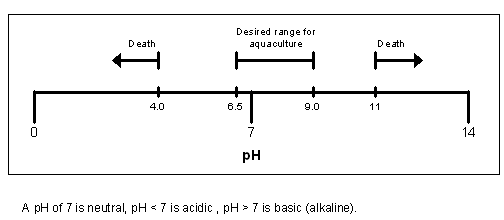pH stands for Potential Hydrogen. The scale is from 1 to 14 with 1 being acid, 14 being alkaline and 7 being neutral. It is a measure of whether the water in your pond is on the acid side or on the alkaline side. The blood of fish is 7.4, so an ideal pH for your pond would be 7.4. However, most fish can tolerate a pH which is anything from 6.5 to 9.0. If the water becomes too acidic and drops below a pH of 5 the fish will almost certainly die
What causes a pond to become acidic with a low pH?
- Carbon Dioxide gets into all ponds from the air. When it reacts with the water it forms Carbonic Acid which lowers the pH. If you live in a hard water area the water will be more alkaline which is good. If you live in a soft water area the water will be more acidic which is not so good. If you must top your pond up, at least let the tap water sit in the open air in a bucket for a day, this way a lot of the dissolved carbon dioxide which would make your pond acidic will have dissipated and you will have helped to raise the pH.
- When fish or any life form breaths out they create Carbon Dioxide. When this is in contact with water it converts into Carbonic Acid which lowers the pH. Luckily, plant life, through the process of photosynthesis, uses up carbon dioxide which raises the pH, but only during daylight hours, at night, the whole process is reversed.
3. All rain is acidic to a greater or lesser extent. The pH of a pond can plummet after heavy rain.
4. Another cause of acidity in ponds is fallen leaves. Oak leaves, Pine needles, Acers, Plum or Flowering Cherry trees are particularly acidic. Aquaplancton will eat away any fallen leaves, neutralising any acidity raising pH levels favourable to aquatic life. This causes algae and blanket weed to die out naturally as they thrive in acidic conditions.
Alkalinity
The result of any pH test is only an indication, as the pH can vary at different times of the day depending upon photosynthesis and the respiration of flora and fauna. To get an average reading, it is best to test the pH level early in the morning when it will be at its lowest and again at dusk when it will be at its highest. The majority of ponds tend to be on the acid side, but if your average readings suggest your pond is on the alkaline side, you can still use Aquaplancton, in these cases the pH tends to stay about the same and in any case will not increase beyond a maximum of 8.3 which is within the comfort scale for your fish. If the pH is less than 5.0 or higher than 11.0 it is unlikely that your fish will survive.
Alkalinity is being decreased all the time by bacterial action which produces acidic compounds. For this reason, small top-up doses of Aquaplancton are recommended for smaller ponds 2 or 3 times a year in spring, summer and autumn. Large ponds and lakes are a lot more stable and maintain their equilibrium pH value for much longer, sometimes several years, so therefore need topping up a lot less often. Aquaplancton keeps the pH at the optimum level and the conditions within your pond or lake balanced and stable.
The post Acidity/Alkalinity and pH levels in Ponds appeared first on Aquaplancton: 01298 214003.

